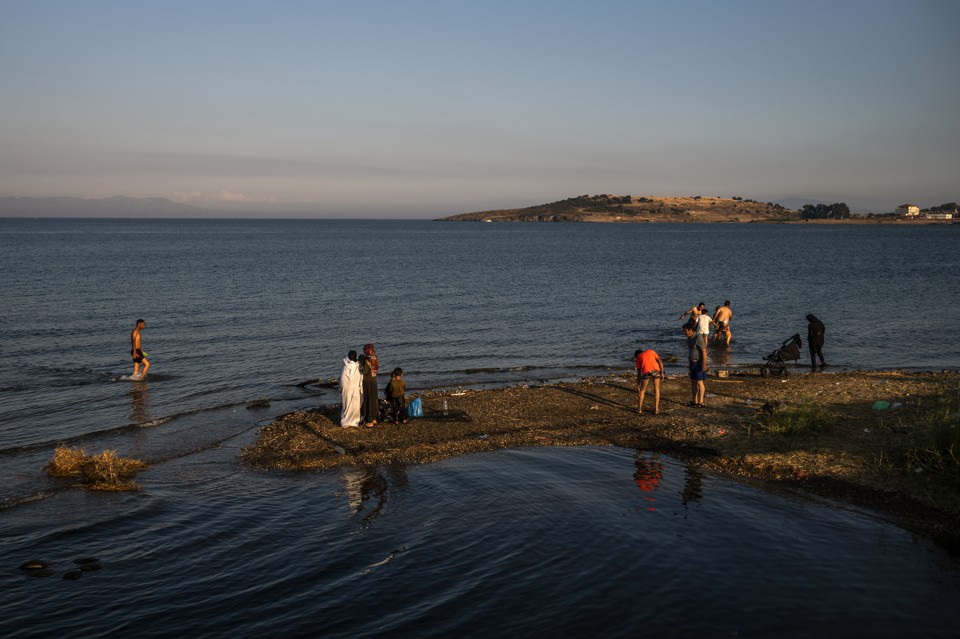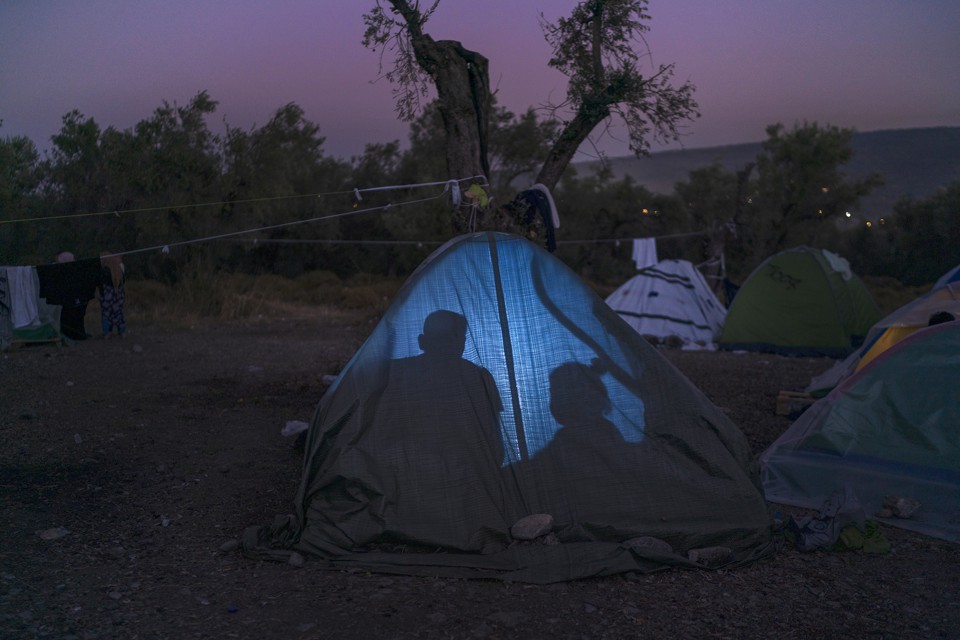MORIA, Greece—From the olive grove just outside the high cement wall—one topped with spirals of razor wire, enclosing one of Europe’s most infamous holding pens for asylum seekers—you can see all the way clear to the Aegean Sea, gray-blue in the distance. It’s a straight shot across the water to Turkey, just six miles away at the narrowest stretch, an ancient Dardanelles trade route.
Moria, on the Greek island of Lesbos, is a symbolic place—a hinge between the Middle East and Europe, the eye of the needle through which migrants must pass as they travel from east to west, a pressure point between Istanbul and Brussels. It is where the collateral damage of contemporary history—Afghanistan, Syria, Turkey—crosses the threshold into Europe. Moria is where geopolitics becomes European politics becomes national politics. Every new arrival here could one day translate into rising poll numbers for right-wing parties across the Continent, parties divided by language and culture that find common ground in wanting to block these humans from entering.
The United States’ border with Mexico is not the only immigration flash point in the West. What Juárez is to America, Moria is to Europe. The arrivals here have come by boat from across the Mediterranean, now the most dangerous border on Earth.
From up close, Moria is a chaotic mass of humanity. Built to house about 3,000 people, it is now home to more than 13,000 (including an estimated 1,000 unaccompanied minors)—more than it has ever held. They wait, sometimes for more than a year, for the slow wheels of Greek bureaucracy to turn, to review their asylum applications, to send them to the mainland for a decision. Winter is approaching, and many of these 13,000 live outside the camp’s walls, in tents pitched on the surrounding hillsides, without electricity or running water, which are provided only inside the camp. NGOs, which lease the land for the tents, help run basic services and report atrocious conditions. Fights break out in the hours’-long food lines. Women are afraid to use the toilets for fear of harassment. In September, a woman died in a deadly fire.
How did it come to this? Because Europe allowed it to come to this.
The huge number of migrants who sought to enter Europe in 2015 spurred a strengthening of border controls and a rise in the popularity of right-wing parties. Then came Brexit, and Donald Trump, and shifting political winds. It came to this because of the European Union’s inability to set an immigration policy that would help individual member states whose own infrastructure was not enough to bear the burden. Greece was—still is—recovering from a crippling economic crisis at the time of the 2015 migration crisis. Its current conservative government, which took power in July with a more law-and-order approach to immigration, has asked for additional European help. But so did its previous leftist government. Not enough help has yet arrived.
What is Moria? It is where Europe’s ideals—solidarity, human rights, a safe haven for victims of war and violence—dissolve in a tangle of bureaucracy, indifference, and lack of political will. It is the normalization of a humanitarian crisis. It is the moral failure of Europe.
On a hot day last month, I walked around the Moria camp. I heard the cries of children, and also their laughter, and saw women from Afghanistan and Somalia wearing long robes and head scarves. Some baked flatbreads in makeshift tandoor ovens that are undeniably fire hazards; a round Greek man sold fruit from the back of a truck outside the main gate—1.50 euros a kilo for yellow apples and peaches. On the road that abuts the camp wall, I smelled the ripe stench of bags of rotting garbage. Nearby was a natty 20-year-old Afghan man who had set up a makeshift barber shop, with hair sprays and combs, his clippers plugged into an extension cord that stretched through the metal fence into the camp. “I want to go to America,” he told me.
If the Moria camp were to bear a message, it would be: “Welcome to Europe. Now go home.”
Read: Europe’s complicity in Turkey’s Syrian-refugee crackdown
And yet people come. And they don’t go home. According to the United Nations High Commissioner for Refugees, Lesbos receives 40 percent of all the arrivals by sea to Greece, and Moria is operating at seven times its capacity. Almost every day, boats arrive on Lesbos from Turkey, carrying migrants. In September alone, 12,500 people arrived in Greece, mostly from Afghanistan and some from Syria. The number of people who have come to Greece since July is the highest since March 2016, when the EU signed a deal with Turkey pledging 6 billion euros to Ankara so that it would keep Syrian refugees fleeing Syria’s civil war inside Turkey, where they receive assistance from the Turkish state.
That deal largely still holds, but the region is changing rapidly. After Trump effectively gave Turkey the green light this month to push the Kurds, former U.S. allies, back from the border between Syria and Turkey, Turkish President Recep Tayyip Erdoğan threatened to send “millions” of refugees to Europe.
If he does, those refugees will likely wind up passing through Moria—and the humanitarian crisis will worsen. For now, at least, Erdoğan’s rhetoric has been mitigated by reality. The Turkish coast guard has been intercepting migrant boats before they slip from Turkish waters into Greek waters off Lesbos, according to the UNHCR and other NGOs that operate here.
The number of arrivals has been far higher in recent months than in previous years. NGOs attribute the increase to a number of factors: pressure on Afghans to leave Iran, where they are persecuted; the conflict in Syria; Turkey forcibly returning Syrians to border areas. Yet the overall figures are still sharply lower than they were in the summer of 2015, when large numbers of refugees passed from Turkey to Greece and crossed borders across the Balkans into the heart of Europe—about 890,000 going to Germany alone—redrawing Europe’s political map, and leading to the rise of right-wing parties.
Read: The U.S. moves out, and Turkey moves in
What has changed since 2015 is that an emergency—the great wave of migrants—is now a semipermanent reality.
I suppose that should tell you something about Europe, or Greece, in 2019, about the banalization of a crisis: that what could be a resolvable situation has instead ossified into a routine. The Moria camp is a 10-minute drive from the port of Mitilini, the largest city on Lesbos. The island has long been a tourist haven, but like Lampedusa in Italy, it has become shorthand for a refugee emergency. When I was in Mitilini, a British border-guard vessel and an Italian coast-guard ship shared space with pleasure boats, and in the cafés on the harbor old men held worry beads as they sat for long hours, sipping coffee and playing backgammon.
The route to Moria winds its way up hills, past a crumbling Ottoman-era port, past an industrial compound, until you reach the front gate of the camp. Inside, metal containers used as housing are stacked in levels of two or three. Outside are other encampments, including one run by Movement on the Ground, a Dutch NGO, that has 740 people in 70 tents. Some of the tents have potted flowers outside their entrance flaps. Here, in the olive grove, they try to keep things more human than in the camp itself. Up the road, outside the camp’s walls, white gravel has been spread to make space for larger, sturdier tents that the UNHCR will soon erect to house even more people.
Nearby, I spoke with Tahira Azimi. She was from Herat, Afghanistan, and had been living in Iran, having fled the Taliban with her husband and four children, ages 17, 13, 6, and 4. Tehran has begun to push Afghans out after years of accommodating them. She was 32, with a long black robe, a purple head scarf, and an easy smile. She told me that she had arrived here this summer, on her third try. She wanted a better life, she said, and hoped to go to Germany. Greece was welcoming, but she was afraid that it might not let her stay.
Another Afghan, Yousof Mohammadi, translated for me. He said he was almost 17, from Kabul, and wanted to join his brother, who had been living in Germany—Yousof didn’t know which city—for four years. Their father had worked for the Red Cross in Kabul, he told me, and had been killed by the Taliban.
Vulnerable people, such as women, victims of sexual violence, and unaccompanied minors, are supposed to be kept in safe areas inside the Moria camp, but because of overcrowding, many live outside, in the olive grove. There are no formal schools. People come and go as they please. Across the road from the camp gate, a long line of people waited in the heat outside a Médecins Sans Frontières medical clinic. Even inside the clinic, people waited—pregnant women in need of health care, a young boy with a croupy cough. At the camp, Greek state doctors mostly carry out checks as part of the asylum process, nothing more, Marco Sandrone, an Italian aid worker for Médecins Sans Frontières, told me.
Sandrone said he had worked in hot spots around the world—Haiti, South Sudan, Sierra Leone, the Democratic Republic of Congo. It was a shame, he said, to be operating a refugee camp in Europe. The problem, he said, was a lack of political will, Greece’s and Europe’s.
In 2015, the dead body of Alan Kurdi, a 3-year-old Syrian Kurd, washed up on a Turkish beach. He became a symbol of the crisis. But it didn’t end. Britain pledged to take in 3,000 children, but three years later, after Brexit took all the political oxygen, it had only received about 220, according to the Home Office. The UNHCR estimates that more than 4,500 unaccompanied minors are now in Greece. NGOs have been calling on European countries to share in the resettlement. Europe’s long and dark history casts shadows into the future. There are calls for a contemporary Kindertransport, similar to what was done to move hundreds of Jewish children from Czechoslovakia to Britain after Kristallnacht in 1938.
Read: The refugee crisis, 6 months after Alan Kurdi’s death
Angela Modarelli, the mental-health-activity manager at the Médecins Sans Frontières clinic here, works with children at Moria. The conditions are atrocious, she says, and she sees the results. “They stop playing. Sometimes they stop communicating and they look at the ground. They refuse to talk,” she told me. Others resort to self-harm, such as cutting themselves. “It’s not simple for me to realize that this is Europe,” she said. “These kids are deprived of their hope here.”
The boats arrive on Lesbos often in the northern part of the island, so close to Turkey that my phone picked up Turkish cellphone networks. Here, boats have been arriving almost every day in the inky darkness of night. Once they pass from Turkey into Greece, a border writ in water, they are brought ashore with the help of Frontex, Europe’s border police. A small and jolly group of volunteers—from Ireland, England, Iceland, Australia, the United States, Germany, and France—works for NGOs that keep a lookout. The volunteers rush to the beaches to deliver blankets and water and food when they learn that boats will land. Kind, young, engagé, they, too, are part of the normalization of the crisis. There’s even a bit of nostalgia in their voices when they talk about the hot days of 2015.
Greece’s government said recently that it would increase border patrols in the water and speed up the mechanisms for processing asylum seekers, keeping those who qualify for refugee status and sending back those who don’t. Last month, it passed a bill to make deporting people back to Turkey easier, which received fierce criticism from NGOs that said it would scale back protections for the vulnerable. (In practice, Greece deports very few people, Theodoros Alexellis of the UNHCR told me.) The government also said it would start to relocate people from island camps such as Moria to the Greek mainland, where they would have better access to medical and other facilities, but those words have yet to translate into action. In Greece or in Europe.
“It’s all very abstract,” says Gerald Knaus, the president of the European Stability Initiative, a Berlin-based think tank, and an architect of the EU’s 2016 deal with Turkey. The entire decision-making system in Greece has broken down, he told me. Europe follows the rule of law, and it cannot deport Afghan asylum seekers to Turkey. But the rest of Europe should share the burden with Greece and put in place a system to process asylum seekers in eight weeks, he said. That hasn’t happened—presumably because of resistance among other EU member states.
In September, France, Germany, and Malta agreed to take some migrants rescued from boats off the Italian coast. But this was seen as a belated, and modest, response to the Italian populist government’s vocal demands for help. For the most part, borders are back. Refugee resettlement is hardly a priority. Instead, it is a third rail domestically. “It’s not just the Greeks. It’s the EU. It’s Brussels. It’s the European Commission,” Knaus said about the Moria crisis.
The lack of action sends a message: “that basically they could live with the status quo,” Knaus said. Now things are changing in Turkey, not only with the Kurds, but the Syrian government’s push into Idlib province, one of the last areas held by rebels, sent more Syrians into Turkey. Sooner or later, they might spill over into Greece. “If you have 10,000 people on a Greek island inside the EU, how does it presume it can deal with much larger flows that are likely to come?” Knaus asked.
Over house wine in a café in the Mitilini harbor one evening, a senior European diplomat gamed the regional dynamics. Erdoğan talks a big game—that he’ll unleash a wave of migrants to Europe—but the Turkish coast guard is still intercepting boats, noted the diplomat, who asked not to be identified talking about Turkey’s domestic politics. Maybe we should have tried to bring Turkey closer to Europe years ago, he said. The Afghans in the camp looked pretty well off, he speculated; they seemed like economic migrants, not refugees. But how can anyone tell? I thought to myself.
If people like this—migrants from foreign lands—come to his country, the diplomat said, there will be problems of integration. That word contains worlds. For him, integration means adhering to the traditions of his country’s national identity, in exchange for access to the generous welfare state. It is based on a certain set of assumptions—cultural, religious, economic—and if you don’t fit in, you don’t fit in. It’s hard to imagine this problem ever going away, I think, this us versus them in Europe.
Greece has its own vocabulary for this. Stretched thin by economic crisis and inefficiency, it is pulled between xenia, the ancient tradition of hospitality, of welcoming the stranger, and xenophobia. At a conference in Athens last month, an Afghan immigrant to Greece asked Prime Minister Kyriakos Mitsotakis why his government had evicted migrants from a building in Athens that they had occupied. He listened, but was brusque. “If you’re entitled to international protection, you will get it, and you will get it earlier and you won’t be held hostage,” he said. “If your goal is to come to Greece in search of a better economic future, I’m afraid we’re not in a position as Greece to accommodate this.”
How will this end? There was truth in Mitsotakis’s answer. Greece can’t accommodate everyone. It needs Europe’s help.
I think of a small girl I met outside the gates to the Moria camp one afternoon. She pointed to my notebook and then to herself. She wanted me to give it to her. I wavered, she insisted, but then I shook my finger no. Better to keep the notebook, and write that she and thousands of other children are stranded here in Greece, with no clear future, and it’s on Europe’s conscience to act.
Source link
 Black America Breaking News for the African American Community
Black America Breaking News for the African American Community



